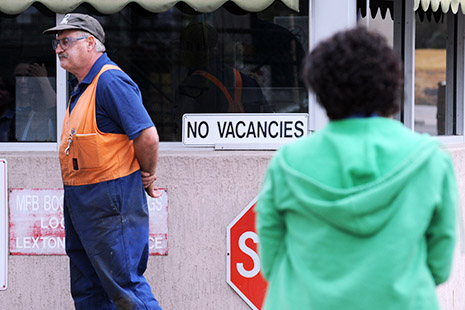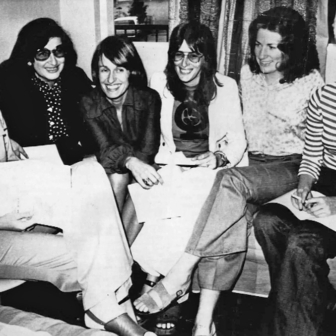CHRISTMAS has come early to Mount Street, Mount Druitt. Well, not Christmas, exactly, but a red-and-green polyvinyl chloride substitute for the spirit of Christmas – a blow-up Santa as big as the Ritz popping in and out of a blow-up box. The offices of Max Employment, in the western suburbs of Sydney, have been decked with everything but holly. There are streamers of paper Santas, a puce-coloured blow-up reindeer and a banner with the words “Santa’s Jobs Workshops.”
Two Easter Island–sized Islanders in trackies and tatts come in and go out again. Inside, they log on and off the employment agency’s computers, one of the requirements of the activity test imposed on people on the dole. Job-seekers anywhere in Australia who receive the payment with the Orwellian name Newstart must demonstrate that they are out looking for “suitable” paid work, going to job interviews and accepting “suitable” offers, but all this activity won’t hold them up long in Mount Druitt. Here, there are almost as many job agencies as jobs: seven agencies, in fact, and twelve full-time jobs when I last checked.
There’s so little work around that hundreds of people rush to Coles or Woollies if they advertise a casual position for a cashier or trolley collector. But the unemployment industry is thriving, as it is in many other areas where joblessness is over 10 per cent, not least because the government pays the agencies fees, whether the people on their books get a job or not.
That’s how it’s been since the Howard government privatised the old Commonwealth Employment Service, or CES, in 1998. What had been a public service was chopped up into market shares and assigned to non-profit and commercial providers.
By now the biggest single share – nudging 10 per cent – is in the hands of MAXNetWork Pty Ltd (which trades as MAX Employment), the wholly owned subsidiary of an American corporation. The company’s financial statement filed with the Australian Securities and Investments Commission shows that in the year to 30 September 2010, MAXNetWork collected about $125 million in fees and about $41 million in related payments from the government, a reliable revenue stream that contributed to after-tax profits of $30.4 million that year.
The figures give a glimpse of an industry that has stayed out of the spotlight while scooping up about $1.7 billion a year in government funding (and hundreds of millions more if providers double up and run recruiting businesses on the side). Instead, attention falls on the supposed beneficiaries of all this largesse – the people on the dole or on disability benefits. Yet a study by the Department of Employment, Education and Workplace Relations published in 2006 found that people left to their own devices were only ten per cent less likely to end up with a job than those being churned through the system. And things are much as they were. In a recent review, consultant Lisa Fowkes, the former chief executive of the Job Futures network of community-based employment services, concluded that the system has been “tweaked, not fundamentally changed.”
The agencies have been forced to tender three times since the CES was replaced by the Job Network and then replaced, in turn, by Job Services Australia. The third time was in 2009. The tender process was contentious. Some organisations refused to participate. Some that had scored well in previous ratings of performance lost their contracts. Once the dust settled, half of the Rudd government’s $3.8 billion Job Services Australia contract was in the hands of private enterprise, with MAXNetWork projected to receive $321.7 million over three years. When I submitted a series of questions about its finances and its operations, the company declined to comment. So did Mission Australia, which picked up the second-largest share, valued at $246 million. Next came the Salvation Army with $206.7 million, then another for-profit, JobFind Centres Australia Pty Ltd, with an estimated $177.4 million, ahead of another 125 companies, charities and community organisations, with contract shares valued at anything from $40,000 to $97.9 million.
The agencies are in competition, but one effect of a system subject to commercial pressures but strangled in red tape is that there may be little to choose between them. I proceed from Max Employment to Mission Employment and from Mission Employment to JobFind, where the placards and posters say “Anything is possible” rather than “All I want for Christmas is a job.” But going from one agency to another and one suburb to another only serves to strengthen the impression that these offices, with all their furniture and the sometimes out-of-date job lists tacked to their walls, are like props in a Potemkin village version of the performance-based contracting model set out in the paperwork.
WHEN the current system came into operation in 2009, I happened to have started work on The Short Goodbye, a book about the financial crisis, so I was talking to people who had just lost their jobs. Gary Leffley had been working as a crane operator at an aluminium factory in Sydney when about half the men there were sacked on the spot. Fifty-three at the time, Leffley was something of an anomaly, a neat, meticulous man who lived on his own and liked to make rueful observations about what was going on around him. He was just the person to bring back reports from the front line.
Leffley had gone to the Mission Australia job agency in the suburb of Merrylands and been offered routine advice: undertake a training course. The agencies are expected to offer people the training or preparation they may need to help them find a job, drawing on a fund that provides up to $1100 a head for those who face barriers to employment. In practice, this can mean that people are instructed at great length in how to dress for interviews, write resumes and research jobs online. Cast adrift after years of steady employment, many will find this training useful at first, as Leffley did. But he wasn’t convinced he needed a one hundred–hour course, which is what it was – on paper, at least.
“What I found was you’d go in there, you’re supposed to spend four or five hours there. Some days after an hour and a half they’d say just ‘sign off and we’ll say you’ve been here for four hours,’” he said. He went to the agency’s office, around the corner from his rented flat, day in and day out, but not even his case manager said goodbye when he was transferred from one agency to another. While he found the other agency more satisfactory, other job-seekers are happier with Mission Australia. The problem is not with the particular agency but with the system.
In a research project begun at the time the CES was being privatised, political scientist Mark Considine investigated the reform of employment services in Australia, Great Britain and the Netherlands for his book Enterprising States: The Public Management of Welfare-to-Work. When he looked at them in the late 1990s, there were significant differences between public, for-profit and non-profit services in all the countries, says Considine, now dean of the Faculty of Arts at the University of Melbourne. The public employment service was impersonal but more equitable, giving everyone a similar share of attention. The non-profits dealt with far fewer people but spent more time with them. The for-profit services were somewhere in between.
Ten years later the differences had either flattened out or disappeared altogether. This convergence was particularly striking in Australia, where the whole system had been put up for tender, says Considine. The agencies had all adopted a business model that had them creaming off the more promising job-seekers and parking the rest with the growing pool of long-term unemployed.
Yet the government has swathed the system in so much red tape that Jobs Australia, the peak body for the non-profit agencies, has found its members spend half their time administering and complying with the 3000 pages of requirements written into the contract, including nine minutes in every hour on paperwork that duplicates information collected by Centrelink. No doubt the boxes all get ticked – and yet half the people on the books fail to get any job at all, not even a casual job for half a day a week.
AFTER sampling the services for myself, I have a fair idea why. I first did so almost ten years ago, when the Howard government’s Jobs Network was in operation. I had taken leave from my job as a newspaper feature writer to research a book about low-wage jobs by doing some of the jobs myself; one was in an agricultural town in the Riverina. I telephoned an employment agency in the town beforehand and was instructed to fax my resume and references. Walking into the office a few weeks later and mentioning my resume earned me a blank look from the Cassandra I had spoken to on the phone. “We get hundreds of them,” she said, handing over a fistful of forms for me to fill in. I was handed more forms at the next three agencies I visited. I dropped in on all four offices day after day, but none of them ever contacted me about a job and none thought to tell me that anyone with a pulse could get a job at the chicken processing plant, as I eventually did.
I tried job-hunting again when I was writing the book about the financial crisis in 2009. I had just been retrenched by the Australian, so I decided to see if Job Services Australia was any better. Looking online, I was bemused to find that the government measured the performance of the agencies with “star ratings.” I found one with four out of five stars, not too far from where I lived, chancing on Max Employment in the Sydney suburb of Maroubra. Several other agencies in Maroubra had just closed down after losing their contracts: with 2000 people on the books, all of a sudden, Max Employment was trying to hold them at bay.
I came in the day of the appointment to learn that I was there only to fill in more forms. Keeping me off the streets, I guess. Eventually I got in to see a staff member. The government had made the grandiloquent claim that it would not “give up on those who lose their jobs due to the global recession,” but as far as I could tell my consultant gave up on me the moment I turned my back. The interview lasted seventeen minutes. I let her know I could do office work and she let me know that as someone able to go to another job there and then I had been lumped into what the government called Stream 1, which meant I wasn’t worth a row of beans to the company.
“The government doesn’t give us funding for clients in Stream 1, that’s the catch,” she said. The government had trapped itself in the sort of trompe l’oeil version of policy that has been around since the privatisation of the system. It proclaimed that it had a “compact” with the workers laid off during the recession. But what DEEWR was doing meanwhile was re-ordering the funding arrangements to provide less money for Streams 1 and 2, which included many of the people just made redundant, and more money for the job-seekers in Streams 3 and 4, who faced “significant” or “severe” disadvantage.
Max Employment would have made some money out of me – a grand total of $63 – if it had done everything that the DEEWR website claimed it would do for people in Stream 1 – helping me with my resume and reviewing my circumstances at face-to-face meetings over thirteen weeks. There was no risk of that. I never heard from them again.
Why would companies that operate for profit do something that costs them money instead? But once again, it wasn’t the particular agency at fault. The way the system had been set up forced providers to pick and choose where to put in the effort. The way to make money out of the long-term unemployed in Streams 3 and 4 was to ensure they were doing something, if only another course in preparing for the job interviews that so seldom eventuated. If the agency doubled up as a training enterprise, it could claim for the course - and collect the outcome fees for the progress the person was said to be making. There was no way to make money out of Stream 1. The way to make some money out of Stream 2 was to cream off the job-seekers with the best prospects. It helped explain why so many older people were written off right away.
Two years ago, Pacific Brands, the company that produces Bonds underwear, Berlei bras and King Gee overalls declared it could no longer afford to manufacture in Australia and would henceforth have its stuff made in China. Other factories were closing without anyone but the redundant workers batting an eyelid, but Bonds and King Gee were household names: what with one thing and another, Pacific Brands was soon agreeing to make special provision to support the 1850 workers who were to be laid off.
The textiles union decided to use its limited resources to find out what happened to those employees. Remarkably, it managed to stay in touch with 1193 of them. One in five had worked for the company for more than twenty years, according to Michele O’Neil, the national secretary of the union, but a record as a steady worker did not bring them steady work.
By May this year, the union calculated, 44 per cent were employed, but three in every four of them had only been able to find casual short-term jobs. The advice the employment agencies had handed them was as dispiriting as the result. “The women are told you are going to find work in hospitality, aged care, child care and retail,” said O’Neil – which was true, as far as it went. Those who found work found casualised shiftwork at rock-bottom rates of pay. For the men, the equally dreary advice was to get a forklift licence or a truck licence and look for work in transport, logistics and construction – industries in which the precarious employment on offer is a little better paid.
Intent on minimising unemployment figures, if only by forcing people to find scraps of work (one reason the number who are underemployed now exceeds the number who are out of work), Liberal and Labor governments alike structured the system so that the profits employment agencies make depend on following the course of least resistance. The agencies are paid an “outcome fee” between $675 and $1750 if job-seekers get work of one kind or another and go on working for thirteen or twenty-six weeks. It could be a job for six hours a week for thirteen weeks; it could be ten jobs spread over thirteen weeks. The agency gets the fee either way.
What it means to job-seekers is a life of continuing uncertainty. It hasn’t escaped the attention of employers that they can call on a pool of casual labour whose agreement with Centrelink means they can’t say no. Michael Beattie is another original – a rigger who taught himself to read music and play the recorder to while away the interminable hours stuck in the cabin of a crane high up in the air. Beattie often gets work through his job agency, Salvation Army Employment Plus at Port Stephens, north of Newcastle, NSW.
They’re very good, he says, but if they call him in to tell him about a job that’s come up, there’s always a break in the conversation. “You ask the rate of pay. They can’t say. It happened when I was offered work as a crane driver.” The job was at a goldmine in another NSW town . There was the usual argument afterwards about money. “The agencies send you to these jobs and the employer underpays you. But if you reject the job you can be in breach of your employment agreement.”
“The debate is all about the unemployed but there are a whole lot of unemployed people who get up every day, who’ve worked for twenty years straight, who are perfectly willing to work but cannot get a job,” says Lisa Fowkes, whose paper for the Whitlam Institute, Rethinking Australia’s Employment Services, ought to be required reading for politicians broadcasting their views about the 2.6 million working-aged Australians outside the labour market. Fowkes drills through the data to work out what effect the system is having on the people who get the blame for its shortcomings.
“If you look at the raw numbers… you see that just eight or nine per cent of the long-term unemployed get full-time work,” says Fowkes, who is familiar with the realities on both sides of the counter. “If you have a caseload of 100, 150 people, you’re going to be making a decision every day about how much time you spend with people.
“But no one is taking responsibility for the fact that many people don’t have a positive experience of the system and many people don’t end up with a job. Read the description on the website and you’ll think you’ll be getting a personalised service,” she says. “But in most cases you won’t, even though everyone is doing what they are supposed to.”
The people in question may find the experience as unsatisfactory as Gary Leffley and the Pacific Brands workers did, but they had better not vote with their feet. If they neglect to show up at the job agency when they’re supposed to be there – if only staring in mystification at the computer – they may find their NewStart payment suspended for eight weeks. The number of people “breached” for failing to comply trebled between 2009 and 2010, Maree O’Halloran, the president of the National Welfare Rights Network, tells me. The organisation has made representations to government about it but the government is more insistent about compliance than ever. “If we’re talking about making people job-ready that’s what employers would expect,” Kate Ellis, the minister, says firmly on the phone from Western Australia.
KEITH Hemingway is the sort of person the minister is talking about – a job-seeker long ago consigned to Stream 4 who only gets noticed when he does the wrong thing. Hemingway lives in Port Kembla, up the road from the sprawling steelworks, in a little room over one of Port’s many hotels. It used to be that around this time, after the afternoon shift, the steelworkers were three–deep at the bars up and down the street. Now there’s just three old men – Macedonians – playing chess for points on the back verandah of the Port Kembla Hotel, where Hemingway sits having a beer with a friend. He looks knocked about, with a shock of white hair and a gap between his front teeth. He has been in and out of work for years but as it happens now has a job at a local recycling place. He works every Monday and Tuesday but his case manager at his job agency in Wollongong keeps leaving messages telling him to come in for his appointment on Monday.
“They make the appointment on them days, then wonder why I don’t turn up,” he says. The first time it happened he reminded them he worked Mondays, surprised they didn’t remember, since they had found him the job. Then it happened again. They’ve done it five times now, Hemingway says, not sure why it upsets him so much. I suddenly remember what Gary Leffley said the last time we talked. “The way it works, you’re just a number in a machine and they spit you out the other end…”
Leffley, meanwhile, had gone from the agency around the corner from his flat to another agency in Parramatta, which spruced up the resume he had produced in the hundred-hour resume course and found him a job in a meatworks, cutting up pork with a bandsaw. He stuck it out for six months, went back to his agency and was signed up with a labour hire firm. Over the next six months he worked in four or five factories. The meat pie factory was followed by the factory making Cheezels and then he found himself at Aristocrat making bits of poker machines. Sometimes he would get an SMS at five in the morning asking him if he could start work at six. “I worked almost every week. Mostly it was three or four days. Then it stopped. I rang them up a few times and they’ve said there’s nothing.”
The government used to subsidise labour hire firms for doing what they would do anyway, paying those that were registered as job placement organisations for placing people in jobs. This had been stopped. Curious about how the agencies now split fees and percentages with companies paid for providing labour, I contacted one agency’s head office to ask about the commercial relationship with particular labour hire firms. The amiable PR woman went away to check and rang back to say that each of their offices was free to make their own arrangements.
What was more striking from Leffley’s point of view was that the offers of work from the labour hire firm had stopped so suddenly – six or seven months after they started. He kept calling but they never called back, says Leffley, who has just gone onto disability benefits.
And me? I never heard another word from Max Employment in Maroubra, but I did hear from a public servant in Canberra. He wanted to know what I thought of the services they had provided. I ignored the letter. Three weeks later, I got another one, sharply reminding me I hadn’t replied. I filed it. •




